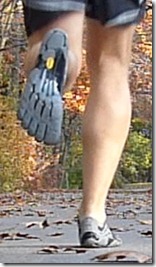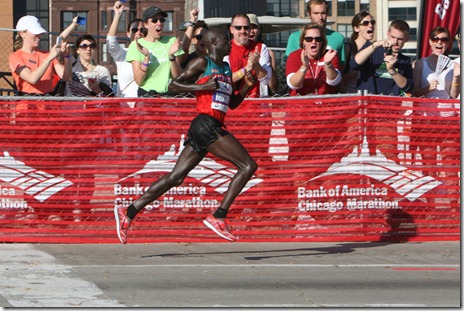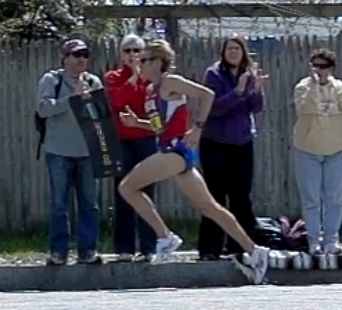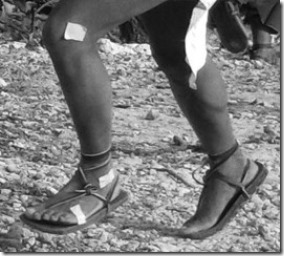 A few weeks ago I wrote about a study that looked at the effectiveness of self-directed gait retraining for increased step rate in runners. That study found that runners could indeed make lasting changes to step rate on their own, and increased cadence altered biomechanical variables that might increase risk of injury. These changes included reduced vertical impact loading rate (could reduce risk of tibial stress fracture), and reduced peak hip adduction angle (could help with iliotibial band syndrome and patellofemoral pain)
A few weeks ago I wrote about a study that looked at the effectiveness of self-directed gait retraining for increased step rate in runners. That study found that runners could indeed make lasting changes to step rate on their own, and increased cadence altered biomechanical variables that might increase risk of injury. These changes included reduced vertical impact loading rate (could reduce risk of tibial stress fracture), and reduced peak hip adduction angle (could help with iliotibial band syndrome and patellofemoral pain)
In this post we’ll take a look at another study that investigated the effects of a self-directed cadence training protocol on runners. Here’s the Abstract
Scand J Med Sci Sports. 2015 Feb 4.
In-field gait retraining and mobile monitoring to address running biomechanics associated with tibial stress fracture.
Willy RW1, Buchenic L, Rogacki K, Ackerman J, Schmidt A, Willson JD.
Abstract
We sought to determine if an in-field gait retraining program can reduce excessive impact forces and peak hip adduction without adverse changes in knee joint work during running. Thirty healthy at-risk runners who exhibited high-impact forces were randomized to retraining [21.1 (±1.9) years, 22.1 (±10.8) km/week] or control groups [21.0 (±1.3) years, 23.2 (±8.7) km/week]. Retrainers were cued, via a wireless accelerometer, to increase preferred step rate by 7.5% during eight training sessions performed in-field. Adherence with the prescribed step rate was assessed via mobile monitoring. Three-dimensional gait analysis was performed at baseline, after retraining, and at 1-month post-retraining. Retrainers increased step rate by 8.6% (P < 0.0001), reducing instantaneous vertical load rate (-17.9%, P = 0.003), average vertical load rate (-18.9%, P < 0.0001), peak hip adduction (2.9° ± 4.2 reduction, P = 0.005), eccentric knee joint work per stance phase (-26.9%, P < 0.0001), and per kilometer of running (-21.1%, P < 0.0001). Alterations in gait were maintained at 30 days. In the absence of any feedback, controls maintained their baseline gait parameters. The majority of retrainers were adherent with the prescribed step rate during in-field runs. Thus, in-field gait retraining, cueing a modest increase in step rate, was effective at reducing impact forces, peak hip adduction and eccentric knee joint work.
© 2015 John Wiley & Sons A/S. Published by John Wiley & Sons Ltd.
What was unique about this study was that the researchers screened runners beforehand and only included those who exhibited high baseline impact loading rates. The value that constituted “high” corresponded to the average value for a cohort of runners with a history of tibial stress fracture. Thus, they were looking at runners who had impact loading rates that might put them at risk of injury and therefore might benefit most from a protocol that increases step rate.
Methods
The researchers measured a variety of biomechanical variables both before and after a cadence training protocol. The protocol consisted of 8 runs, during a portion of which subjects ran at a cadence target that was 7.5% higher than their baseline. The retraining utilized a faded-feedback design in which cadence feedback was provided during runs 1-3, 5, and 7. The rationale for this was that it might help subjects to internalize cadence changes if feedback was gradually removed.
Cadence feedback was accomplished by using a Garmin footpod that displayed real-time cadence on a GPS watch. A control group went through the same protocol but was not instructed to increase their cadence (it was not displayed on their watch). All subjects returned again 30 days after the end of the 8-run protocol to see if any changes would be retained in the absence of continued cadence training.
Results
After the 8 run protocol the gait retraining group exhibited significantly increased stride rate. Stride rate for this group was on average 166.5 steps/min at baseline, 180.8 steps/min post-training, and 180.6 steps./min 30 days post-training. This shows that the subjects had retained the new, higher stride rate even 30 days after feedback was removed.
The experimental group also exhibited significant reductions in instantaneous impact loading rate (-18.9%), average vertical loading rate (-17.9%), peak hip adduction (about 3 degrees less), and eccentric knee joint work (-26.9%). These changes were all retained 30 days later.
No differences between baseline, post-training, or 30 days post training were observed in the control group.
Comparisons between the two groups revealed that stride rate was significantly higher, and loading rates were significantly lower in the experimental group both post-training and 30 days post-training. Peak hip adduction and eccentric knee joint work did not differ between the groups.
Comments
I like this study because it provides additional evidence that runners can make lasting changes to their cadence outside of the lab/clinic setting, thus saving both time and money. Consistent with other studies, this one also shows that increasing cadence can alter biomechanical variables that have been associated with risk of injuries like tibial stress fractures, patellofemoral pain, and iliotibial band syndrome. I also like that they pre-screened subjects to include only those who exhibited baseline loading rates consistent with a population of runners with a history of stress fractures. Thus, they were looking at a population of runners who might benefit most from such an intervention.
Given the increasing number of devices that are capable of displaying running cadence (including both phone apps and GPS watches), the protocol here seems like a logical option that should be accessible to most runners. I routinely utilize the cadence function on my Garmin 620 (mainly out of curiosity), and the iSmoothRun app will give you this information on a phone. I haven’t actively attempted to retrain my own cadence, but if I were going to try I think I’d prefer going this route over using something like a metronome or music with a target tempo.
The missing link, however, continues to be the lack of interventional studies that take runners suffering from one of the injuries mentioned above through a gait retraining protocol like the one studied here. This will go a long way toward bridging the gap between gait retraining, resulting biomechanical changes, and their potential role in injury resolution. In the meantime, attempting to increase cadence a bit might be a worthwhile experiment if you suffer/have suffered from tibial stress fracture, PFPS, or ITBS.



















To perform the study you suggest, the problem would probably be to find an adequate group of subjects.
In any case, it is true that with attention, one can slightly change his stride, to adapt it to a new kind of effort.
Cadence seems to me to be even easier to change then for exemple foot strike.
You’ve written before about how cadence changes with speed — at what speed were the 8 training runs performed? Were they all performed at the same speed?
Don’t think it says in the paper, I assume it was a self-selected pace. They did have GPS recordings of all the runs so if there were outliers they would have known I suppose.
Great info Peter.
Just wanted to add that if you wanna train your cadence you can use the metronome function of iSmoothRun in automatic mode, so that metronome kicks in only when you cadence get below your target.
The metronome can be set either in the 160-180 range or in the 80-100 range. I find easier to use the later and synchronize one foot than trying to match both.
Lambros
Pete,
In the opening paragraph you state:
“That study found that runners could indeed make lasting changes to step rate on their own, and increased cadence altered biomechanical variables that might increase risk of injury.”
I’m confused by “increased cadence altered biomechanical variables that might increase risk of injury.”
Are you trying to say “increased cadence = reduced risk of injury.”
Yeah, poorly worded on my part. The idea is that increased cadence may reduce risk of injury to the knee or tibial stress fracture via the changes it induces to one’s running mechanics.